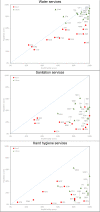Access to water, sanitation and hygiene services in health facilities in sub-Saharan Africa 2013-2018: Results of health facility surveys and implications for COVID-19 transmission
- PMID: 34172045
- PMCID: PMC8231746
- DOI: 10.1186/s12913-021-06515-z
Access to water, sanitation and hygiene services in health facilities in sub-Saharan Africa 2013-2018: Results of health facility surveys and implications for COVID-19 transmission
Abstract
Background: The COVID-19 pandemic has highlighted important needs in water, sanitation and hygiene (WASH) services and standard practices for infection prevention and control in sub-Saharan Africa. We assessed the availability of WASH and standard precautions for infection prevention in health facilities across 18 countries in sub-Saharan Africa, as well as inequalities by location (rural/urban) and managing authority (public/private). Data from health facility surveys conducted between 2013 and 2018 in 18 sub-Saharan African countries were used to estimate the access to an improved water source within 500 m, an improved toilet, soap and running water or alcohol-based hand rub, and standard precautions for infection prevention at health facilities. Rural-urban differences and public-private differences in access to services were calculated. We also compared population level access to health facility access to services.
Result: Overall, 16,456 health facilities from 18 countries were included. Across countries, an estimated 88 % had an improved water source, 94 % had an improved toilet, 74 % had soap and running water or alcohol-based hand rub, and 17 % had standard precautions for infection prevention available. There was wide variability in access to water, sanitation and hygiene services between rural and urban health facilities and between public and private facilities, with consistently lower access in both rural and public facilities. In both rural and urban areas, access to water, sanitation and hygiene services was ubiquitously better at health facilities than households.
Conclusions: Availability of WASH services in health facilities in sub-Saharan Africa has improved but remains below the global target of 80 % in many countries. Ensuring adequate access to WASH services and enforcing adherence to safety and hygiene practices in health facilities will be essential to minimize the risk of COVID-19 transmission.
Keywords: Coronavirus disease (COVID-19); Health care facilities; Inequalities; Sub-Saharan Africa; Water, Sanitation and hygiene.
Conflict of interest statement
The authors declare that they have no competing interests.
Figures





References
-
- United Nations Children’s Fund (UNICEF) and World Health Organization. Progress on household drinking water, sanitation and hygiene 2000–2017: Special focus on inequalities. 2020.
-
- Yang H, Bain R, Bartram J, Gundry S, Pedley S, Wright J. Water safety and inequality in access to drinking-water between rich and poor households. Environ Sci Technol. 2013;47(3):1222–30. - PubMed
MeSH terms
Substances
Grants and funding
LinkOut - more resources
Full Text Sources
Medical

